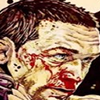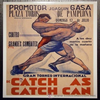George Foreman
Spooked: Organized Crime and The Rumble in the Jungle – An Interview with George Foreman
The “Rumble in the Jungle” took place on October 30, 1974 in Kinshasa, Zaire. Formerly known simply as the Congo, just three years prior the CIA backed Joseph Mobutu had renamed the country Zaire in 1971. It’s one of the most iconic fights in boxing history, yet there is a little-known, alternative history to perhaps the greatest sporting event of the 20th century. According to Foreman, the true story of his historic fight against Muhammad Ali is nothing short of a true unsolved mystery.
A former two-time heavyweight champion of the world and 1968 Olympic gold medalist, today Foreman is a beloved cultural icon. But underneath the jovial exterior lays the heart of a lion. A force of nature in his prime, Foreman is among the greatest heavyweight boxers of our time. But according to the Mean, Lean, Fat Reducing, Grilling Machine spokesperson, the story of his most famous fight against Muhammad Ali is one marred by corruption.
“How do you explain all that,” Foreman asks Shirley Norman in a 1976 THE RING magazine interview. “Big George” had went on to li st a number of out of the ordinary circumstances and events to occur to the now former champion upon touching down on the African continent. “Such weird things kept happening,” said Foreman. “Like, I got hit (cut) over the eye, my dog mysteriously got hurt, they kept changing my living quarters, and then I got into a five-car accident.”
Blessed with the opportunity to follow up with Foreman some 40-years later, these often-overlooked events in the lead up to the “Rumble in the Jungle” were among the first questions I posed to Foreman in late June, 2019 during my phone interview with the legendary American icon.
st a number of out of the ordinary circumstances and events to occur to the now former champion upon touching down on the African continent. “Such weird things kept happening,” said Foreman. “Like, I got hit (cut) over the eye, my dog mysteriously got hurt, they kept changing my living quarters, and then I got into a five-car accident.”
Blessed with the opportunity to follow up with Foreman some 40-years later, these often-overlooked events in the lead up to the “Rumble in the Jungle” were among the first questions I posed to Foreman in late June, 2019 during my phone interview with the legendary American icon.
“All those things happened,” recalled Foreman. “My dog, you know I took my dog, it’s very strange,” said Foreman. According to the former Olympic gold medalist, “I was showing someone how he would go over the bank and I was doing whatever, he would jump over, he would bring this big bag and everything,” and to Foreman’s horror his four-legged friend would mysteriously get hurt. The “out of the ordinary” circumstances didn’t stop there either. “For a few days, I really thought he had broken something. He hadn’t broken anything but he got injured.” Later according to Foreman, “By the time we got to the car, people had forgotten their driver’s licenses. That was strange.”
And while you might think the end of Foreman’s bad luck came to a close there, a string of incidences to come would begin to paint an entirely different picture to the one the mainstream, popular culture portrays today. Interestingly, in a 2007 Reuters report titled, “No sour grapes over Ali fight, says Foreman,” author Ed Stoddard writes that Foreman, “Insists he was drugged before his famous 1974 clash with Muhammad Ali in Africa.” According to the report, Foreman believes, “It was an inside job involving his trainer at the time, the late Dick Sadler.”“Most everybody would like for me to just keep quiet about that,” says Foreman following my initial line of questioning concerning the string of bizarre and unusual circumstances to occur before the fight. “And I never will because history is a strange thing. So many people let things slip through and then nobody gets the message. You know, one day I’ll be dead and gone, and that piece of news and the pieces you are putting together are just as an important part of history as the fights (themselves),” explained Foreman. Stoddard would go on to quote Foreman as stating, “Just before the fight with Ali, my trainer handed me a glass of liquid and said, ‘Here’s your water.’” According to Foreman, “As I took a swig, I almost spit it out. Hey, this water taste like it has medicine in it.”
The 800-pound gorilla in the room is what exactly was in that water? According to George, “These guys weren’t pharmacists or anything, you know?” It’s a complex story, with varying degrees of depth and a consistency over time that leads one to believe the sincerity in Foreman’s voice as he tells the true story of the “Rumble in the Jungle” today. “You give this to this guy, giving it to this guy, who gives it to Sadler and they don’t have any idea what they’re giving somebody,” Foreman explained. “I could have been dead. I never look back on this with contempt or anger because they didn’t know what they were doing.”
 I had a doctor who traveled with us to Africa,” explained Foreman in an interesting theory on the chain of custody involving the spiked drink. “At first, it was like a vacation for he and Sadler because he and Sadler were friends. I can’t think of his name now, but it will come back to me.” Within a few weeks of arriving in Africa, the doctor brought along to be Foreman’s personal physician was hardly speaking to George any longer according to Foreman.
I had a doctor who traveled with us to Africa,” explained Foreman in an interesting theory on the chain of custody involving the spiked drink. “At first, it was like a vacation for he and Sadler because he and Sadler were friends. I can’t think of his name now, but it will come back to me.” Within a few weeks of arriving in Africa, the doctor brought along to be Foreman’s personal physician was hardly speaking to George any longer according to Foreman.
“We drank at breakfast a little sip of water and some tea,” Foreman explained. “Then in the afternoon, dinner we have a little sip, not much, and tea,” said Foreman in a regimented process his camp repeated religiously just before weigh-ins. “And then we get on the scale and say, GOT IT! Two-seventeen and a half most of the time,” according to Foreman.
“And so, we would always do that, but just before I fight, he would give me some water. He would say take a drink of this water. He would wrap tape around the bottle of course and give me maybe three or four pieces of ice. And I chewed them and man was that delicious. Ha! And that water was so delicious. And we did this before every fight, so in Africa we did the same thing and this time I took a drink of the water and I said, “Man, this water taste like it got medicine in it,” Foreman explained. “And he got me right in the face and said same water as always.”
“And you almost have to be a mathematician to understand what I just said,” said George as he paused to listen for my reaction. Foreman again repeated himself, this time with an emphasis on the defensive, angry tone Sadler took upon noticing something wasn’t quite right with the medicine tasting drink. “He got in my face and said SAME WATER AS ALWAYS,” recalled Foreman in a masterfully crafted theatrical display of story-telling.
“And then I didn’t want to offend him,” said Foreman in recalling the fateful chain of events. “So, I took another drink, and I took a drink, and he said take another drink (so) I took another drink. And I said “Man, this water got medicine in it”. And he said, “Same waters as always!” This was someone Foreman trusted, they had been with each other through thick and thin.
There was little reason to believe his friends, those within his own camp whom he trusted the most would be out to sabotage his livelihood, career and ultimately his future. “And so, the clock goes tick-tick- tick and he come back to me and says I’m drinking the water and there’s nothing in the water, look. And you put all that together,” Foreman explained in attempting to lay out a complex story for me in as simplified terms as possible.
“All that was working together. That doctor, I tell ya I never saw that doctor again,” said Foreman. As to the effects of the medicine tasting water? According to Foreman, “The bell rang the first round and Sadler said get him! And I tried to knock him out, everything!” Foreman would go to describe when the effects of the medicine tasting water really started to take ahold of him. “By the third round I was tired,” Foreman explained. “And then it hit me in my legs,” said Foreman. “GET HIM, YOU GOT HIM NOW,” Foreman’s corner would yell to him during the fight over the noise of the ruckus crowd. “Staying on him, staying on him, and maybe (by) the fourth-round man, I could barely breath, hold my head up.”
 According to George, there were many rituals his camp followed, including specific instructions from his corner that they would periodically remind him of during the fight in order to prevent the heavyweight champion from getting caught up and blinded by the fog of war. On this particular night, it wasn’t the same water or corner as always in Kinshasa as they threw the playbook right out the window. It’s a real-life tale from the dark side, when Foreman entered the ring against Ali on that fateful October 30th, 1974 night, he had stepped into the Twilight Zone and Rod Serling was calling the fight.
According to George, there were many rituals his camp followed, including specific instructions from his corner that they would periodically remind him of during the fight in order to prevent the heavyweight champion from getting caught up and blinded by the fog of war. On this particular night, it wasn’t the same water or corner as always in Kinshasa as they threw the playbook right out the window. It’s a real-life tale from the dark side, when Foreman entered the ring against Ali on that fateful October 30th, 1974 night, he had stepped into the Twilight Zone and Rod Serling was calling the fight.
“We discussed, we also discussed Sadler, Archie Moore and I, if you ever get knocked down don’t listen to the refs., look to us,” Foreman explained. “So, you can see in the ring I’m on the canvas, I stuck my hand up and I saw Sadler getting ready to get up and (he) told me no, stay down! Put your hand down, wave your hand down. And then he said GET UP! And when I got up the fight was over,” summarized Foreman in how the fight ultimately played out. “I only stayed down because he told me,” said Foreman.
“So, when I think about what happened in Africa, they had this myth that someone is going to kill you if you do something that gangsters don’t do.” According to the former Olympic gold medalist, “He (Sadler) was scared of those guys, like they were ghosts.”
Perhaps there was good reason to be afraid? Foreman was a former sparring partner and close friend of the indominable Sonny Liston. “In Liston’s earlier years he had scared people and broken a few heads on behalf of John Vitale, a St Louis mob boss to whom he also acted as a chauffeur,” writes author Richard Williams in his May 22, 2015 article for The Guardian titled, “Muhammad Ali’s phantom punch has us scratching our heads 50 Years on.” According to the report, “During his (Liston’s) rise towards international fame he was managed by Frank “Blinky” Palermo, a Philadelphia-based associate of the notorious Frankie Carbo, who – among other distinctions – had organized the murder of Bugsy Siegel in 1947.” Sadler, a one-time trainer of Liston, no doubt would have networked with this same set of organized crime figures of the period. And while Carbo would ultimately end up pulling some serious time towards the end of his career, reportedly granted early release from prison due to poor health and dying in 1976; it’s this same underworld crime syndicate that pervades the sport of professional boxing even today.
“Get up sucka, no one’s gonna believe this,” Muhammad Ali reportedly said to Liston following the infamous phantom punch that sent Sonny crashing to the canvas in late May of 1965. Liston, a former heavyweight champion of the world who lost his title to Ali in a pair of controversial fights was believed by the FBI to have taken a dive on orders from the mob according to boxing.com’s Jeffrey Sussman in an April 23, 2019 piece titled “Boxing’s Baddest Man.” As to Sadler’s motivations, George went into a lengthy explanation about the motives behind the inside job that sabotaged his camp
 “I was laying with my then wife, we were trying to patch up things,” Foreman said. “I was out of boxing and I reading this book The Last Mafiosos, The Last Mafia or something like that and this guy wrote how they would get in and take over people’s restaurants and who was involved with this gang. He would come up with these stories about different celebrities, especially about the Mayor of San Francisco that I liked back in the day and I said man, anyone whose name appears in this book has to be a roach, rat or something. Scum!”
“I was laying with my then wife, we were trying to patch up things,” Foreman said. “I was out of boxing and I reading this book The Last Mafiosos, The Last Mafia or something like that and this guy wrote how they would get in and take over people’s restaurants and who was involved with this gang. He would come up with these stories about different celebrities, especially about the Mayor of San Francisco that I liked back in the day and I said man, anyone whose name appears in this book has to be a roach, rat or something. Scum!”
“And my dad went through the book and guess whose name appears in the book? George Foreman. And I started reading and I said what? He tells a story that back in the day Jimmy Hoffa had a trial and he (was) really going to be down the river,” Foreman explained. “But the whole jury they had selected were all African Americans and someone got in touch with Jimmy and said, look, I know how you can get off,” explained Foreman. “Let’s send Joe Lewis down to the court room. And Joe Lewis went down, shook hands with Jimmy Hoffa and gave him a hug. And they acquitted him because all the people on the jury were defending him after they (had) saw Joe Lewis hugging him.”
“So now, I was reading a book and a guy is telling that story and the guy said look, I know Dick Sadler who’s the manager of George Foreman. He can get you in touch with Muhammad Ali and can come and do the same thing. Then all the pieces fell together for me,” Foreman recalled. “And then me, you know, it got me because then I knew that Sadler was just scared. Someone scared him and told him to do that, someone scared him.”
When pressed on who he thought that someone might be, Foreman again reiterated his original point about spooks, ghosts. “I think that, you know, back in the day they tell stories about if go outside and you go to the right or you go by the graveyard, there are ghosts out there and those ghosts will catch you and choke you,” said Foreman. “And you better neither not look to the left when you walk or you better whistle as you walk. And stories get passed as you go on and the stories get past just on and on, and on. And I think that just anybody could have just come up and said, “Sadler, they are going to kill you if you don’t make George… it could have been anyone. It wouldn’t have to be anyone of importance.”
Foreman would go on to explain Coventry, or ostracism. “In the Bible, it tells about an imaginary snake that (is) supposed to be so poisonous that no one wants to run into it,” said Foreman. “Coventry, they call it, Coventry. It’s not real but you’ve probably heard that term, Coventry. It’s an imaginary monster that doesn’t exist and anyone can bring their kids to be afraid. So, it didn’t have to be who, it’s just that’s what they told him.” Leading one to the notion that Dick Sadler was heavily involved in organized crime and feared both being ostracized by the underground crime syndicate, or perhaps worse yet, eliminated altogether.
The noted Chinese philosopher Sun Tzu famously once said, “All warfare is based on deception.” It’s not the first-time an athlete has claimed to have been drugged prior to a fight; it’s a technique that has been alleged to have been used in the past by the Japanese mixed martial arts promotion Pride Fighting Championships. And one which is likely more common than you might initially think. The allegations bring a new meaning to the term “rope-a-dope” and shed light into a corner of boxing history most would prefer to keep in the dark. The conventional story today of that fateful night in Kinshasa, Zaire is an injustice to the truth and the actual events which unfolded in the lead up to one of the greatest sporting events of our time.






